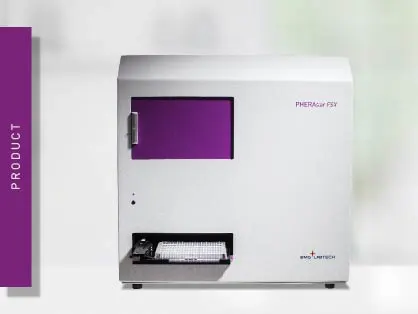
PHERAstar FSX
Powerful and most sensitive HTS plate reader


How is quorum sensing a possible answer to antibiotic resistance? Learn how microplate readers can be used for antimicrobial assays and the determination of minimal inhibitory concentrations.
The lab of Dr Crystale Lim Siew Ying, Associate Professor and the Deputy Dean at the Faculty of Applied Sciences of UCSI University, Malaysia, focusses on antibiotic resistance profiling. A key area of their research is quorum sensing inhibition as an alternative way to address this problem.
Crystale´s laboratory works on community antibiotic resistance profiling as part of the Malaysian Antimicrobial Stewardship Programme. As an extension of this area of research, she also works on quorum sensing inhibition with Vibrio fischeri and Chromobacterium violaceum used as models to identify potential inhibitory compounds from plant sources1.
Antibiotic resistance has been recognized as a global healthcare crisis with antibiotic resistant infections estimated to cause 10 million annual deaths by 2050 2. While the race is on to identify and develop new antibiotics, scientists have turned to alternative approaches to address disease. One of these approaches is to suppress bacterial virulence via quorum sensing inhibition.
Quorum sensing is a mechanism that bacteria use to monitor and respond to changes in environmental conditions, in a population density dependent manner 1, 3. In this process, bacteria ‘communicate’ by secreting small, diffusible signaling molecules called autoinducers. This system has been shown to regulate a variety of processes in bacteria, including virulence factor production, surface protein expression and biofilm development 4.
The identification of a potential candidate that induces quorum sensing inhibition without interfering with bacterial growth could be a promising target for anti-pathogenic drugs, as it places less selective pressure on pathogens and avoids the development of resistant bacteria.
Crystale’s first encounter with a microplate reader was during her PhD candidature where she extensively used plate readers for her research. Since then, Crystale has continued to appreciate the capabilities and reliability of BMG LABTECH’s microplate readers.
“The FLUOstar Omega has been useful in antimicrobial and quorum sensing inhibition assays on model bacteria of various colors, including bioluminescence”, says Crystale, “Antimicrobial studies using Minimum Inhibitory Concentration (MIC) are relatively straightforward, usually using turbidity as a measure of bacterial growth at OD600.”
“Things are a little different for quorum sensing inhibition assays using bacteria models such as C. violaceum that is based on the production of a violet-colored pigment, violacein, as an indicator of active quorum sensing, or V. fischeri that is based on bioluminescence. For quorum sensing inhibition, both the growth and color indication of the bacteria model should be assayed simultaneously during treatment with a potential inhibitor to show that the inhibitor does not interfere with bacterial growth”, explains Crystale. Examples are shown in the figures here below.
Crystale’s innovative work on quorum sensing inhibition earnt her the John David Williams Memorial Award from the International Society of Chemotherapy in 2013 5. Her achievements are many, with a solid focus to improve health outcomes and the environment through her research, networks, and broader community projects. This dedication earnt her the inaugural L’Oreal-UNESCO for Women in Science (FWIS) National Fellowship (Malaysia) in 2006.
The FLUOstar Omega is regarded as an “essential laboratory work horse”. Crystale’s research has included cytotoxic and apoptotic assays for studies into cellular health and mechanisms of action, where the reader is the laboratory’s “one-stop shop”.
“Most common absorbance-, luminescence- and fluorescence-based assays are able to be run without having to hunt high and low for spectrophotometers, luminescence readers and fluorometers”, Crystale explained.
Crystale has also worked with fluorescence-based promoter analysis assays in E. coli and works extensively in RNA and DNA isolations during the course of her research in real-time PCR gene expression studies. In these studies, the 16-spot LVis plate is of great use when processing many samples for concentration and purity determination.
Crystale’s reader is now 9 years old and still performing exceptionally well. BMG LABTECH’s local distributor Progene Link Sdn Bhd is “… essentially like your friendly neighborhood service provider – always happy to help, suggests workshops and webinars, gently reminds you to maintain the reader properly, and is there for you in your time of need”, explains Crystale.
The FLUOstar Omega is also used by UCSI University for teaching purposes, as the user-friendly MARS data analysis software is a boon for even undergraduate students to easily learn the capabilities of the microplate reader.
If you would like to contact Associate Professor Dr Crystale Lim Siew Ying and her team to learn more about their research, please email crystalelim@ucsiuniversity.edu.my or connect with Crystale on LinkedIn at www.linkedin.com/in/crystale-siew-ying-lim-6866218a
The application note Monitoring bacterial cell-to-cell communication "quorum sensing" using a BMG LABTECH microplate reader shows a multiplex approach to elucidate the effect of changes in environmental condition on the growth and bio-luminescence in V. fischeri. Further peer-reviewed papers on quorum sensing inhibition assays with BMG LABTECH microplate readers can be found in BMG LABTECH’s scientific publication database.
Powerful and most sensitive HTS plate reader
Most flexible Plate Reader for Assay Development
Flexible microplate reader with simplified workflows
Upgradeable single and multi-mode microplate reader series
Absorbance plate reader with cuvette port